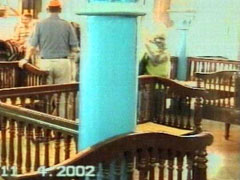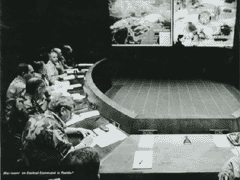 |
||||||||||||||||
 |
||||||||||||||||
 |
||||||||||||||||
 |
||||||||||||||||
|
||||||||||||||||
 |
||||||||||||||||
 |
The Delegation of Perception | 'There are no more simple images ...' | ||||||||||||||
The interest in this theme arouse from various sources. It is clear since quite some time, that the perception and evaluation of our image production has been changing into a complex and enormously wide field. In contrary to this there is still the impression, that up to now images are mostly regarded and handled as indexical representations of the real. Images today in almost any case are perceived via extending and distributing devices. The main systems are working on digital basis, i.e. code, and so further layers and influences are involved. The processes of encoding and decoding are complicated by a constant recoding, as images distributed via networking digital systems have no material underside. As easily as they can be recoded or rewritten by data, digits can be exchanged and therefore images are open to manipulation. These new implications give rise to unknown possibilities of image production, exchange, ... and ways of perception from the Hubble telescope, satellite imaginery to endoscopy and to mixed or virtual realities. Different strategies were invented to create authenticity in this increasing complexity. Scientific images always had needed some explanations, but this now is just one among many approaches, which reach from layering with icons and text, as in TV (CNN) to a handheld unfocused camcorder taping. And each possibility can be read in any direction, as the discussion about the Rodney King or Usama videos show. So hardly anybody questions the new complications of the construction of our sight, further uncertainity about the visible spreads as the actual reactions about 911 demonstrated. The tendency to fall back into old stereotypes is not helpful at all, so I made an attempt to analyse how we deal with this distributed eye sight. The full text can be downloaded as pdf or read in html: download thesis. |
||||||||||||||||
'... the whole world is too much for an image. You need several of them, a chain of images...' J.-L.Godard is quoted by L.Manovich in The Language of New Media |
||||||||||||||||
| Any idea what this image wants
to stand for? So important to know is: it has been published on spiegel-online on the Djerba incident. |
At the moment there are lot of events (papers, symposiums, competitions, exhibitions, ...) concerning and questioning the strategies of image production and perception. A few links actual around 7/2002: iconic-turn iconoclash 911 The problematic of images at the moment lies in the blurring distinction of real and virtual depiction. Paradoxically 'real' image intend to become more abstract, and there is a tendency is to declare them as operational or scientific. Which sometimes seems to be equated with not be understood (in the right sense) without official help. Wahrheit und Fälschung im digitalen Zeitalter Thus on the other side virtual imaginery reaches to be as 'realistic' as possible, mostly simply too real. The Distribution of perception in some of its most extreme consequences can be seen in military development. The War in its online Glory |
|||||||||||||||
 |
||||||||||||||||
| And what kind of impression
do those people have about the effects of their actions? ('War room' at the central command in Florida / Spiegel 13/2002) |
||||||||||||||||
 |
||||||||||||||||
| What would you see in the
picture above if you would not have seen it in almost every media
after 911? |
||||||||||||||||
This work was created as the final project for the EMMA examination at the Merz-Akademie Stuttgart supervising professors: Olia Lialina / Helmut Draxler and: Stephan Gregory |
2002 monika jaeckel support |
|||||||||||||||
 |
||||||||||||||||
 |
||||||||||||||||
